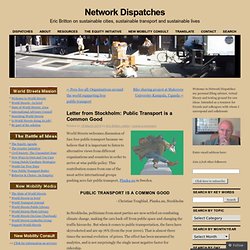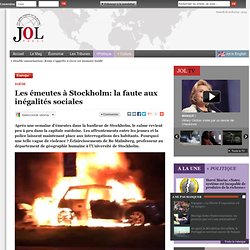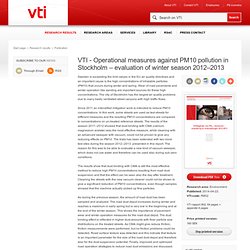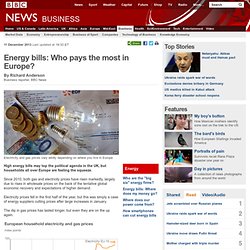

För en avgiftsfri kollektivtrafik som styrs av de som reser och arbetar i den. Home of the global movement for a free public transport. Letter from Stockholm: Public Transport is a Common Good. World Streets welcomes discussion of fare free public transport because we believe that it is important to listen to alternative views from different organizations and countries in order to arrive at wise public policy.

This contribution comes from one of the most active international groups pushing zero fair public transport, Planka.nu in Sweden. Public Transport is a Common Good - Christian Tengblad, Planka.nu, Stockholm In Stockholm, politicians from most parties are now settled on combating climate change, making the cars back off from public space and changing the traffic hierarchy. But when it comes to public transportation, the fares have skyrocketed and are up 76% (from the year 2000). So although there is an understanding of the traffic challenges, but the actual politics make people more dependent on cars and create demand for new city highways.
The most common way to get around the burden of fares is to dodge them. About uPlanka.nu. Les émeutes à Stockholm: la faute aux inégalités sociales. Stockholm, nouveau théâtre de violences urbaines?

Après cinq nuits de violences, le calme est partiellement revenu ce week-end dans la banlieue de la capitale suédoise. Bilan de ces violences urbaines : une centaine de voitures incendiées, des écoles, des commissariats et des centres culturels endommagés, et une trentaine de personnes interpellées. Les émeutes de Stockholm écornent le modèle social suédois. Ces émeutes de Stockholm mettent à mal le modèle social suédois © Reuters - Fredrik Sandberg Après une cinquième nuit de violences , le débat fait rage en Suède sur l'intégration des immigrés, qui représentent environ 15% de la population, se concentrent dans les quartiers pauvres des grandes villes du pays et connaissent un taux de chômage plus important que le reste de la population.
La crainte est forte d'une récupération de la part du parti démocrate suédois, troisième en termes de popularité, le tenant de la lutte anti immigration. Le Premier ministre conservateur Fredrik Reinfeldt, fervent partisan de l'accueil des immigrés, a voulu donner devant le Parlement l'image d'une nation unie. " Je pense qu'il est dangereux de vouloir dépeindre la Suède avec une capitale séparée de ses banlieues. Je ne pense pas que ce soit vrai. Berlin, Nantes and Stockholm – Most Accessible EU Cities. Tourists that we do not think enough about the world over are those with special accessibility needs.

Business owners often feel obliged to add in accessible features to their facilities in order to avoid risks and meet regulations. But it is only recently that the global tourism industry started catching on to the vast scope of barrier free travel in terms of the revenue that it can generate and the benefits it can have for society as well. The world today counts 1.3 billion disabled people among its population, and they are likely to travel if they have the opportunities. When you consider their family and friends the total accessible tourism market comes to around 2.2 billion people. Statistics reveal that this demographic has more than $8 trillion in disposable income annually. Clearly this means that it is good business to make as many services barrier free as possible. Air Quality Now - Operational measures against PM10 pollution in Stockholm – evaluation of winter season 2012–2013. Sweden is exceeding the limit values in the EU air quality directives and an important cause is the high concentrations of inhalable particles (PM10) that occurs during winter and spring.

Wear of road pavements and winter operation like sanding are important sources for these high concentrations. The city of Stockholm has the largest air quality problems due to many badly ventilated street canyons with high traffic flows. Since 2011 an intensified mitigation work is intended to reduce PM10 concentrations. In this work, some streets are used as test streets for different measures and the resulting PM10 concentrations are compared to concentrations on un-treated reference streets. The results of the season 2011–2012 showed that dust binding with CMA (calcium magnesium acetate) was the most effective measure, while cleaning with an advanced sweeper with vacuum, could not be proven to give any reducing effects on PM10. Pollution in Stockholm, Sweden. Energy bills: Who pays the most in Europe?
11 December 2013Last updated at 19:33 ET By Richard Anderson Business reporter, BBC News Electricity and gas prices vary wildly depending on where you live in Europe High energy bills may top the political agenda in the UK, but households all over Europe are feeling the squeeze.

Since 2010, both gas and electricity prices have risen markedly, largely due to rises in wholesale prices on the back of the tentative global economic recovery and expectations of higher demand. Electricity prices fell in the first half of the year, but this was simply a case of energy suppliers cutting prices after large increases in January. The dip in gas prices has lasted longer, but even they are on the up again.
But as the chart below shows, Europe cannot be treated as a single entity, for there are massive differences between individual countries in what households pay for their power. Taking exchange rates out of the equation, Helsinki is the cheapest of the 23 European cities surveyed for electricity prices.